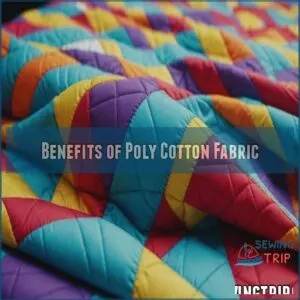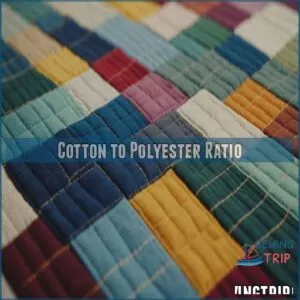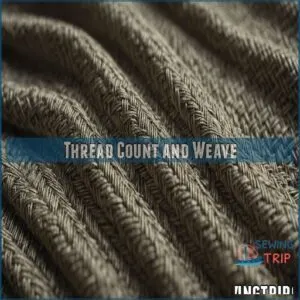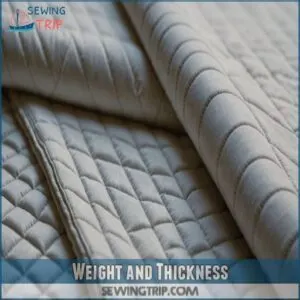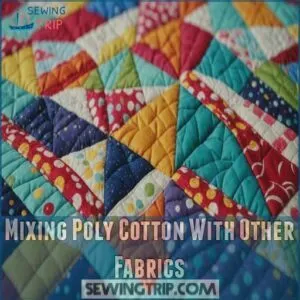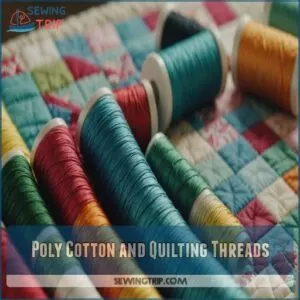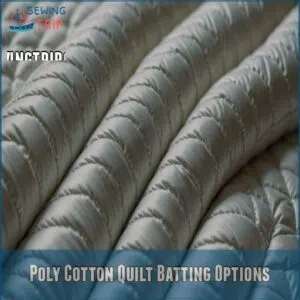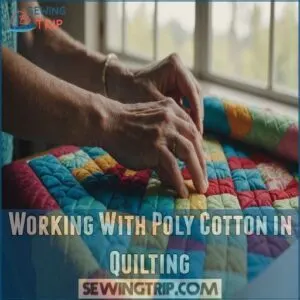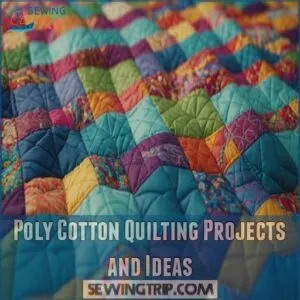This site is supported by our readers. We may earn a commission, at no cost to you, if you purchase through links.
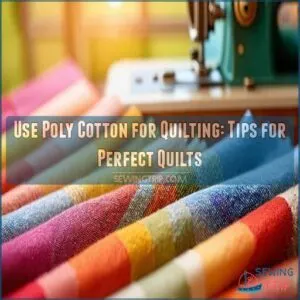 Using poly cotton for quilting offers you a blend of strength, comfort, and vibrant creativity. It’s tough as nails with tear resistance while staying breathable, perfect for a cozy night’s sleep.
Using poly cotton for quilting offers you a blend of strength, comfort, and vibrant creativity. It’s tough as nails with tear resistance while staying breathable, perfect for a cozy night’s sleep.
Imagine vibrant colors and playful patterns—you can easily craft quilts that look like art. Plus, maintenance is a breeze; toss it in the wash, and you’re good to go.
Just watch out for little quirks like shrinkage; pre-washing is your best buddy. When working with poly cotton, consider its shrinkage potential, especially if you plan to wash your quilt in warm water, which can cause cotton-polyester blends to shrink. And don’t forget the batting options like polyester blends that play nice with poly cotton.
Ready for more tricks and tips? Stay tuned for colorful insights!
Table Of Contents
Key Takeaways
- You’ll appreciate poly cotton’s durability and strength, making your quilts last longer.
- It’s versatile and easy to customize, letting you create unique quilt styles.
- You’ll find it’s breathable and comfortable, perfect for all seasons.
- Poly cotton is easy to care for, saving you time and effort.
Benefits of Poly Cotton Fabric
When you’re considering fabrics for your next quilt, poly cotton offers impressive durability and strength, making it a reliable choice.
You’ll appreciate its versatility and easy maintenance, leaving more time for creativity and less for endless ironing and care.
Durability and Strength
Ever fretted over your quilt’s lifespan?
Poly-cotton steps up with impressive tear resistance and seam strength, outlasting pure cotton.
Balancing fabric weight and thread count, this blend offers durability.
Quilting with poly-cotton means that your projects stand the test of time.
Its superior thread strength and weight make it a reliable choice for both novice and seasoned quilters.
Versatility and Customization
Explore poly-cotton quilting for endless versatility and customization.
This fabric lets you craft unique poly-cotton quilt styles with vibrant color options and diverse print designs.
You can easily switch between fabric weights and explore different quilting designs.
Whether you’re using polyester thread or considering quilt batting, poly-cotton adapts beautifully to any quilting project, offering flexibility for your quilting stitches and thread characteristics.
Breathability and Comfort
When you’re snuggling under poly-cotton quilts during hot summer nights, the breathability benefits become clear.
This fabric mix breathes easier than pure polyester, ensuring comfort for sleep.
The fabric weight impact can’t be overlooked as it offers balanced warmth without the sweat.
Toss in cotton batting for a cozy quilt sandwich.
Mastering quilting techniques is your secret to summer serenity.
Easy to Care for and Maintain
With poly cotton, quilt care’s a breeze!
Washing instructions are simple: machine wash cold, tumble dry low.
Stain removal is easier than you think; most spots vanish with a quick pre-treat and wash.
Ironing tips? Low heat’s your friend.
Forget about those tedious durability tests; poly cotton’s tough.
Long-term care? Minimal effort for a quilt that lasts.
Choosing The Right Poly Cotton Blend
Picking the right poly cotton blend is essential for crafting a quilt that stands up to time and use.
Consider the cotton to polyester ratio, thread count, and fabric weight to find the best balance of strength, comfort, and thickness for your quilt project.
Cotton to Polyester Ratio
Poly cotton’s mix of wrinkle resistance, similar to polyester’s low maintenance care, and fabric drape makes it a star choice for quilting.
When considering blends, you should weigh the benefits of cotton’s natural breathability and softness, as cotton’s hollow fibers and softness make it ideal for keeping comfortable.
A typical 65% cotton to 35% polyester blend offers strength and quilting weight while maintaining colorfastness.
Whether crafting quilts for friends or family, this blend balances softness and durability, ensuring your creations withstand time and cuddles without breaking a sweat.
Thread Count and Weave
Exploring the art of quilting with poly cotton, thread count and weave take center stage.
A higher thread count results in a smoother fabric texture, enhancing both fabric drape and durability.
When shopping for the perfect poly cotton blend, consider visiting online marketplaces like poly cotton for quilts to explore various options.
Selecting the right weave type impacts the quilt’s look and feel.
For sewing thread choices:
- Balanced weave for durability
- Satin weave for shine
- Twill weave for texture
- Plain weave for simplicity
Weight and Thickness
You’re considering fabric weight and thickness to make your quilt excellent.
Thicker materials can affect quilt loft and batting weight, so choose wisely.
Balance is key; too heavy, and you’ll strain; too light, and it may lack warmth.
Here’s a quick table to help:
| Fabric Type | Weight (oz/yard) |
|---|---|
| Light Poly-Cotton | 4-5 |
| Medium Poly-Cotton | 6-7 |
| Heavy Poly-Cotton | 8-9 |
| Cotton Batting | 2-3 |
| Polyester Batting | 3-4 |
Mixing Poly Cotton With Other Fabrics
When you’re quilting, mixing poly-cotton with other fabrics can be a fun and creative challenge.
Keep an eye on the different weights and shrinkage rates of the fabrics to make sure your quilt looks and feels just right.
Combining With Cotton Fabrics
Choosing the right poly cotton blend for quilting, which often involves a combination of quilting cotton features, leads you to mixing it with cotton fabrics for a vibrant quilt.
Watch out for:
- Pre-washing: Prevents shrinkage issues.
- Fabric weight: Makes sure quilt blocks are uniform.
- Texture contrast: Adds depth to your designs.
- Color combinations: Makes patterns pop.
Grab your quilting supplies and enjoy the creative process!
Blending With Polyester Fabrics
Having successfully blended poly-cotton with cotton, let’s tackle polyester!
Polyester’s sheen contrasts nicely with poly-cotton’s softer drape.
Consider wash compatibility; both generally tolerate machine washing.
Color blending is easier with similar tones.
Texture contrast adds visual interest.
Here’s a helpful guide:
| Fabric Type | Color Blending | Drape Difference | Texture Contrast |
|---|---|---|---|
| Polyester | Easy | More drape | Smooth |
| Poly-Cotton Blend | Moderate | Medium drape | Soft |
| 100% Cotton | Moderate | Less drape | Slightly rough |
| Poly Blend Batting | Easy | Varies | Varies |
Working With Different Fabric Weights
Mixing different fabric weights in quilting can feel like juggling spaghetti and meatballs at times.
But with poly cotton, you can find a wide variety of fabrics online, such as poly cotton quilting fabric options at Poly Cotton Fabrics.
But with poly cotton, here’s what you should know:
- Consider fabric weight impact on block size.
- Adjust seam allowance for layer stability.
- Balance quilting tension to match fabrics.
- Choose batting that complements your quilt design.
These tips simplify your quilting process!
Pre-washing and Shrinkage Considerations
When tackling fabric weights, it helps to know your poly cotton‘s quirks.
Pre-washing can be your secret weapon against uneven shrinkage.
Understanding how cotton-polyester blends shrink is also important, as cotton fibers can shrink considerably when exposed to heat and moisture.
Run a gentle wash cycle and air dry to prevent surprises.
That’s a bit like taming a lion with a feather!
Here’s a quick table to guide your fabric prepping:
| Fabric Type | Wash Cycle | Shrinkage Percentage |
|---|---|---|
| Cotton | Warm, gentle | 3-5% |
| Poly Cotton | Cold, gentle | 1-3% |
| Polyester | Cold, normal |
Poly Cotton and Quilting Threads
When working with poly cotton in quilting, you’ll find that choosing the right thread can make a big difference.
Cotton threads blend well with poly cotton for a classic look.
Polyester options offer added strength.
Cottonized polyester threads combine durability with a smooth finish.
Cotton Thread Compatibility
Choosing the right cotton thread is important when working with poly-cotton fabric.
Pay close attention to thread tension and stitch length for the best results.
Make sure your sewing machine settings accommodate the specific thread weight.
Consider these cotton thread types:
- Cotton thread for matte finish
- Silk thread for a luxurious touch
- Rayon thread for vibrant color
- Metallic thread for sparkle
Polyester Thread Options
Starting a quilting journey with polyester threads offers exciting options.
The durability of polyester thread strengthens your seams, while trilobal variants shine with a luster that adds pizzazz.
When working with polyester, using a universal needle for polyester can make a big difference in the quality of your stitches. Your sewing machine will appreciate the consistency polyester provides.
Consider this:
| Thread Type | Sheen | Durability |
|---|---|---|
| Trilobal | High | Medium |
| Cottonized | Medium | High |
| Monofilament | Low | High |
Enjoy experimenting with these versatile threads!
Cottonized Polyester Thread Benefits
Polyester threads are a popular choice, but cottonized polyester shines in specific ways.
You’ll enjoy its durability and sewing ease, with a matte finish that matches cotton.
It produces less lint than traditional threads, so your machine quilting stays smooth.
Plus, it’s great value for money, offering reliability without breaking the bank.
Quilting advice? Try it with wool batting for a perfect baste.
Poly Cotton Quilt Batting Options
Now that you’ve chosen your poly-cotton fabrics, let’s talk batting!
You’ll find several excellent options, including polyester blends, cotton alternatives, and even luxurious wool or bamboo choices to perfectly complement your quilt.
Polyester Blend Batting
Ever wonder why polyester blend batting is a hit among quilters? It’s all about the loft and low maintenance!
Pairing this with popular patterns like the bayside quilt keeps your projects light and breathable.
Plus, brands like Quilter’s Dream make it easy to care for.
Perfect for both hand quilting and machine projects, it’s your ally in creativity.
Cotton Batting Alternatives
After the comfort of polyester blends, it’s time to talk cotton batting alternatives.
Looking for something different? Consider these options:
- Recycled batting: Eco-friendly and sturdy.
- Organic batting: Gentle on quilts and planet.
- Batting weight and loft: Choose for texture.
- Creative blends: Unique touches.
- Evolving preferences: Follow your quilting heart.
Each offers distinct features for your quilting passion.
Wool and Bamboo Batting Options
Once you’ve considered cotton alternatives, wool and bamboo batting options offer unique benefits.
Wool provides warmth and fluffiness, resisting creases but beware of "bearding."
Bamboo excels in softness and mold resistance, perfect for a luxurious touch.
Here’s a quick comparison:
| Feature | Wool | Bamboo |
|---|---|---|
| Warmth | High | Moderate |
| Mold Resistance | Low | High |
| Price | Higher | Highest |
Choose what best suits your quilting style!
Working With Poly Cotton in Quilting
When you’re working with poly cotton in quilting, you need to focus on techniques for piecing, stitching, and finishing your quilt.
This blend offers a unique combination of ease in handling and dependable durability, making it a favorite choice for efficient and long-lasting quilting projects.
Piecing and Sewing Tips
You’ve got your poly cotton batting sorted, so let’s tackle piecing and sewing.
Keep an eye on seam allowances—accurate seams are your best friends here.
When selecting fabrics for your quilt, consider mixing high-fraying fabrics like cotton and flannel for a unique look. Use quilting tools like rotary cutters for sharp edges and perfect fabric matching.
Don’t forget pressing techniques; they’re like the cherry on top, keeping everything flat.
Enjoy mastering this quilting art!
Quilting and Stitching Considerations
Mastering your poly cotton quilt’s stitching is a breeze if you mind a few details.
Here’s a quick checklist:
- Use proper seam allowances for neat edges.
- Select the right needle size to prevent snags.
- Maintain even fabric tension; it keeps everything smooth.
- Adjust stitch length wisely; it affects quilting density and texture.
Binding and Finishing Techniques
Several binding techniques exist for your poly-cotton quilt.
Consider bias binding for a professional look, or simple straight binding for a quick finish.
You can find a wide variety of quilting fabric poly cotton to choose from for your binding.
Choose a binding that complements your quilt backing.
Neat edge finishes are key; mitered corners add a polished touch.
Explore different binding options to find your favorite.
These finishing touches truly elevate your creation!
Poly Cotton Quilting Projects and Ideas
Explore exciting poly cotton quilting projects like home decor, garment sewing, and unique quilt patterns to showcase your creativity.
Use poly cotton’s versatile blend to make everything from stylish cushions to durable quilts that stand the test of time.
Home Decor and Furnishing Projects
While piecing and sewing with poly cotton, why not explore home décor projects?
Picture poly-cotton throws warming chilly evenings or quilted furniture covers adding flair.
Practical home projects like table runners, placemats, and pillow covers enhance any space’s charm.
These items refresh your home but also give you a satisfying sense of accomplishment and style mastery.
Garment and Accessory Sewing
Imagine sprucing up your wardrobe with poly cotton’s magic.
Sewing techniques, such as using the right thread and needle, like a 50wt thread and an 80/12 universal needle size with quilting cotton, play a key role in creating stunning garments and accessories that last.
Whether you’re crafting a vibrant scarf or a cozy dress, choose patterns that suit poly cotton’s strengths.
Pay attention to fabric care, and equip yourself with the right sewing tools for successful, creative projects.
Quilt Patterns and Designs
Dive into quilt patterns that suit poly cotton‘s personality.
Whether you’re drawn to modern quilt patterns or classic traditional quilt designs, there’s something for every quilter.
For inspiration, visit top quilting blogs like those found here, which showcase breathtaking finished projects from talented quilters, offering an endless array of vibrant color palettes and unique design ideas.
Explore quilt block variations for added flair, or utilize geometric quilt patterns for precision.
Try free-motion quilting designs to explore creativity—you might just find your signature style amid the stitches and seams.
Frequently Asked Questions (FAQs)
Can I use poly/cotton fabric for quilts?
Yes, you absolutely can! Poly-cotton blends offer durability and wrinkle resistance. It’s a popular choice, though some quilters prefer 100% cotton. Ultimately, it’s your call! Experiment and find what you love.
What fabrics are used for quilting?
Quilting often uses fabrics like 100% cotton, poly-cotton blends, and sometimes wool or bamboo for unique textures.
Each offers distinct qualities—cotton’s soft durability contrasts poly-cotton’s strength.
Your choice depends on desired warmth, weight, and feel.
Is cotton a good fabric for a quilt?
Cotton is a fantastic choice for quilts due to its natural fibers, durable weave, and soft finish.
It provides warmth and breathability, giving your quilt a cozy feel.
Cotton is easy to sew and wash, too!
Should I use 100% cotton fabric for a quilt?
Imagine your quilt project taking on a cozy, timeless charm.
Choosing 100% cotton fabric offers a natural feel and vibrant colors.
Though it wrinkles a bit more, it’s ideal for classic, durable quilts.
Can you use polyester fabric in quilts?
You can definitely use polyester fabric in quilts.
It’s stronger and more durable than cotton, though it might feel less cozy.
Polyester adds vibrant colors and resists fading, but remember, it can sometimes be slippery to sew.
Is it okay to use polyester thread for quilting?
In the grand tapestry of quilting, using polyester thread can be a wise choice.
It’s strong and allows seams to lay flat, ideal for piecing intricate patterns.
You’ll find it hides in fabric beautifully.
What type of cotton is best for quilting?
Quilting cotton is your go-to choice for vibrant quilts.
It’s durable, retains color well, and has the perfect medium weight.
While it might wrinkle more than other fabrics, its strength makes it ideal for frequent washing.
Is poly cotton good for sewing?
Poly-cotton’s a popular blend!
It’s stronger than 100% cotton, making it great for many projects.
It’s versatile, too, perfect for clothes or home décor.
You’ll find it easier to work with than some other fabrics.
Give it a try!
How does poly-cotton hold up over time?
Poly-cotton fabric stands the test of time with its durability and versatility.
The blend resists wrinkles and maintains color well, making it ideal for long-lasting projects.
Plus, caring for poly-cotton is a breeze, adding extra appeal!
Is poly-cotton suitable for quilting beginners?
Yes, poly-cotton is great for beginners in quilting.
Its durability and ease of handling make it forgiving.
You won’t wrestle with lots of wrinkles, and it’s easy to sew.
Enjoy your quilting journey!
Do poly-cotton quilts require special care?
Think of your poly-cotton quilt like a trusty old friend needing a little TLC.
Wash it on gentle and tumble dry low to keep it cozy and durable.
Avoid high heat to prevent damage or shrinkage.
Can poly-cotton affect the quilts warmth?
Using poly-cotton in quilts can slightly impact warmth, as it’s less insulating than pure cotton.
While poly-cotton boosts durability, it mightn’t hold heat as well.
For snuggly quilts, consider layering or choosing warmer batting.
Stay cozy!
Is poly-cotton more eco-friendly than cotton?
Picture a lush field.
Poly-cotton blends trade off natural benefits for durability but adding polyester increases environmental impact.
Although cheaper, it’s less eco-friendly than cotton, which is biodegradable and renewable.
Balance priorities when choosing materials.
Conclusion
Quilting with poly cotton has grown in popularity, and it’s no wonder—93% of quilters appreciate its durability and easy care.
Using poly cotton for quilting means you enjoy strong yet breathable fabric that offers vibrant patterns without much fuss.
Remember to choose the right blend and thread, and don’t skip the pre-wash step to minimize shrinkage.
With these tips, you’re set to create quilts that tackle practical needs but also dazzle with color and creativity.

